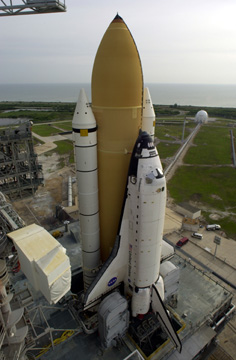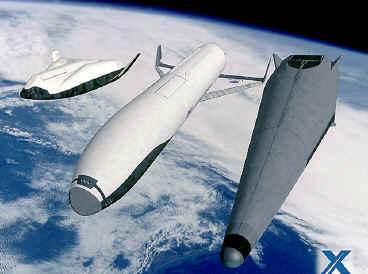SKY RAMP TECHNOLOGY
The basic objective for any spacecraft
launch is to achieve a speed of 17,500 mph (~Mach 24). A speed of 25,000
mph is needed to escape the Earth's gravity and travel to the Mars, but ~Mach 24 is sufficient for a
spacecraft to shut off its engines and "make orbit"; i.e. continually
circle the globe like the moon. Since 95% of the Earth's gravity
remains even 100 miles from the surface, a spacecraft in orbit maintains balance
between Earth's gravity and centrifugal force. While in orbit, the
spacecraft is constantly falling back to Earth as the curve of the Earth moves
away due to the Earth being round.
To easily maintain orbit, a spacecraft needs to circle at least 100 miles from
the Earth's surface to avoid tiny air particles at the edge of the
Earth's atmosphere. This causes "drag" and will "degrade"
its orbit, causing it to "reenter" by falling back to Earth. 100
miles is considered
"low earth orbit". Spacecraft need more thrust to attain higher
orbits, which is needed for varied reasons .
.
As a result, the challenge is not "getting up into Space" 100 miles high. A $100,000 SCUD missile actually goes into Space but runs out of fuel at Mach 3, so it's pulled back to Earth after a few minutes of "sub orbital" flight and lands a few hundred miles away. Mach 24 requires a great deal of intense and sustained rocket power. Since there is little oxygen more than 10 miles from the Earth's surface, air-breathing jet engines are of little value. Rockets must carry their own liquid oxygen "LOX" that is mixed with fuel to provide thrust, They fly almost vertical to quickly escape the aerodynamic drag of Earth's atmosphere. As a result, spacecraft require 10 times more fuel per mission than aircraft. When you see a spacecraft ready for launch, more than 85% of that mass is fuel and LOX.
Mach 24 seems like an amazing speed since military fighter jet aircraft only reach speeds of Mach 2. However, they must continually fight the resistance of the Earth's atmosphere, which also causes tremendous skin heating. When the world's fastest aircraft, the SR-71 spy plane, reaches Mach 3 it actually glows from the heat and expands in size. Half the Earth's atmosphere is found at less than 20,000 feet (3.8 miles). Large jet aircraft have a ceiling of around 45,000 feet (or 8.5 miles) because the air becomes so thin that their wings cannot support their weight and their jet engines become starved of oxygen. Therefore, the best route for spacecraft is to quickly push upward through the resistance of the Earth's dense lower atmosphere.
Launching spacecraft eastward is best to take advantage of the rotation of the earth, requiring around 5% less overall thrust. Launching near the equator also helps. For example, a spacecraft launched from Idaho requires 8% more thrust to make orbit than one from Ecuador. A third factor is angle of launch. A spacecraft launched at 45 degrees requires about 30% more thrust to make orbit than one launched from the ideal angle of 70-80 degrees because of the longer path through the dense atmosphere. Any speed gained from a horizontal launch is lost as energy is bled off during a spacecraft's long upward turn through the dense lower atmosphere. As a basic rule, a spacecraft cannot turn easily once it reaches .5 Mach (~400 mph) because the G force will kill passengers and cause structural failure of the fuel tank walls.
The Earth's dense atmosphere also causes problems with reentry. A spacecraft can pull out of orbit with a minor burst of thrust. The Earth's gravity takes hold and begins to pull it down at an increasing rate. The falling spacecraft will reach high speeds before it enters the Earth's dense lower atmosphere and will burn up from friction unless it has a heat shield or uses its rockets to slow down. The Space Shuttle uses both techniques. Heat shields are normally made from thick ceramic tiles, similar to stone floor tile. As a result, they are heavy and slow spacecraft during launch. Using rocket engines to slow down, like a retro-rocket, uses fuel, which is also heavy. This affects reusable boosters because anything that goes above 150,000 feet (28 miles) needs to carry extra weight in the form of heat tiles and fuel to slow decent back to Earth before wings or parachutes can be employed.
 NASA has always dreamed of a simple "single stage to orbit" Reusable
Launched Vehicle (RLV),
where a
spacecraft takes off and flies into orbit, and later flies home. The RLV would have to
be massive to carry all the fuel needed to make orbit. However, adding heat tiles to a huge
RLV, extra fuel for retro-rocket firings,
and wings to land at an airfield, makes it far too heavy to launch into orbit. The best modern science can design was
the X-33, which could have reached Mach 15 with little payload and return home.
NASA reluctantly agreed the effort was pointless, and it was
canceled in January 2001.
NASA has always dreamed of a simple "single stage to orbit" Reusable
Launched Vehicle (RLV),
where a
spacecraft takes off and flies into orbit, and later flies home. The RLV would have to
be massive to carry all the fuel needed to make orbit. However, adding heat tiles to a huge
RLV, extra fuel for retro-rocket firings,
and wings to land at an airfield, makes it far too heavy to launch into orbit. The best modern science can design was
the X-33, which could have reached Mach 15 with little payload and return home.
NASA reluctantly agreed the effort was pointless, and it was
canceled in January 2001.
Attention has now turned to providing an RLV with a boost, either with a reusable first-stage booster or a ground assisted launch. Expendable boosters have been used for decades since they just fall back to Earth and burn up from friction since they have no tiles for protection, but this makes space launch expensive. A reusable booster must have wings and extra fuel to fly home, or a parachute and recovery system. Assisted launch requires a system to rapidly power an RLV to at least Mach at a 45 degree angle. This is the next big leap in Space exploration.
©2008 Sky Ramp Technology